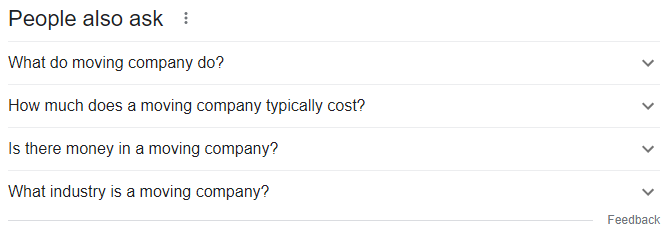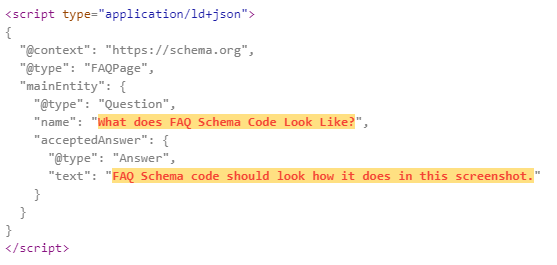What is FAQ Schema and How Could It Help Your Moving Company?
Looking to maximize the reach of your moving company’s website so that you can draw in more people and convert them into leads? Consider FAQ schema.
This is an interesting option that can prove useful for any moving company, from those that are well-established with plenty of traffic and backlinks, to ones that are new or struggling, that haven’t really been able to get their feet planted.
FAQ schema is a way to draw eyes to your site, but it’s a complicated thing to understand and an even more complicated thing to implement. That’s why we, with our over a decade of experience, put together this comprehensive guide on FAQ schema.
What is FAQ Schema?
Before you can determine whether it is worth it to pursue utilizing FAQ to help your moving company, you have to understand what FAQ schema is. Google is constantly changing, which makes it difficult to keep up with all of the new features that you have at your fingertips.
Constant Changes to the Google SERP
Google’s end goal is to make their site quick and easy to use for their users. They do this by constantly pushing their technical design and manipulating the way in which people can find content on their search engine and on their other software, such as Google Assistant.
Many of the changes that they add to their Search Results Pages (SERPs) are designed so that the person searching does not have to click on your website. This can be a burden for those trying to draw in visits to their site, but in the end, you can’t change Google, you have to work within Google’s framework. These “Zero-Click Searches”, as they’re called, can be a great way to put yourself above your competitors and draw impressions which can lead to more clicks and, of course, more moving leads.
How Does FAQ Schema Appear?
There are three key ways in which FAQ schema can appear:

- People Also Ask (PAA) Box: This is a box that can appear on many Google Search Result Pages. Despite the name, these can appear for keyword searches that aren’t questions. This box shows a list of questions and answers that are related to the search keyword. By creating FAQ Schema content, you’re putting yourself in a direct position for Google to add your questions to the PAA box.
- FAQ Rich Snippet: Your FAQ schema can change the way that your page appears on Google. A list of your questions will appear below your Title Tag and Meta Description. These questions can be clicked by those surfing the SERP to reveal the answer.
- Google Assistant: On Google Assistant there are a variety of “Actions” that create more unique and in-depth content for the user. One of these is the FAQ Action. When you use FAQ schema you become eligible for this. That means your answers could appear on voice searches on Google Assistant.
While Google changes the way that people find answers to what they’re looking for, you have to change the way you appear. As you can see, FAQ schema is a great way to get your content to appear in different, unique ways.
How is FAQ Schema Different Than Q&A Schema?
When researching schema options, you may have come across the Q&A schema and thought to yourself; “This seems a lot like FAQ schema”.
Considering they are both ways of getting answers to people searching on Google quickly, it’s understandable how there can be some confusion. However, there is a key difference between the two:
FAQ schema is designed to put answers you wrote on Google, while Q&A schema is designed to put community answers on Google.
That means that you put FAQ schema for questions and answers that are either written within your content or are on a designated FAQ page. Meanwhile, Q&A is a good resource for sites such as Quora and Yahoo Answers. Google does not want Q&A answers to be manipulated by your site.
How FAQ Schema Can Benefit Movers
Considering that there are very few repeat customers in the moving industry since most people only move every 10 years, you have to get your website in front of fresh eyes constantly.
There are a lot of ways to do this. Targeting different keywords with SEO optimized content, PPC advertising such as Google Ads, social media. The truth is that none of these are individually the answer. You have to utilize a mix of different digital marketing avenues to beat out your competition to reach potential clients.
Using all of the new features from Google is a great way to separate your moving website from your competitors and set yourself up for success.
Taking up a larger piece of the SERP with the FAQ Rich Snippet is huge for drawing people into your site. It can easily make up for not being ranked a few spots higher.
Being the answer to voice searches can bring you to a whole different audience.
The People Also Ask Box is a way to show up for different keywords without having to get a page to organically rank on page 1. Though, it should be noted that there isn’t great data on the answer boxes. Those numbers don’t show up in Google Analytics or Google Search Console. However, we can see that other moving companies aren’t pursuing this, which means you have an opportunity to get a leg up.
Implementing FAQ Schema
Before you can do any of the technical work on implementing FAQ schema, you have to create the right content.
Many people, understandably, believe that FAQ schema is only meant for FAQ pages. This is not the case. FAQ schema can go anywhere on your site. The question doesn’t even need to be in your content, just the answer.
A great example of this are Glossary or Terminology pages. The question “What is Moving Valuation” may not appear on that page at all, but the answer does under the definition of “Moving Valuation”.
Once you get great content together that is perfect for FAQ schema, it’s time to write the code.
Google prefers JSON-LD code. In general, it’s best to do what Google prefers, after all, you’re trying to rank on Google. Your code should look something like this:

There are a few different schema markup generators that you could use to avoid manually writing all this code. We recommend Technical Seo for this.
Once you have that code, you can put it above your content and Google should find it when they index your page. If this seems complicated at all, look towards a full-service digital marketing agency. There are even ones out there that are purely dedicated to helping moving companies, such as Marketers for Movers, Movers Development, and Blue Corona. They will have an expert crew that knows that can guarantee that everything is set up correctly and that you’re in the best position possible to get more traction for your site and get more organic moving leads.

